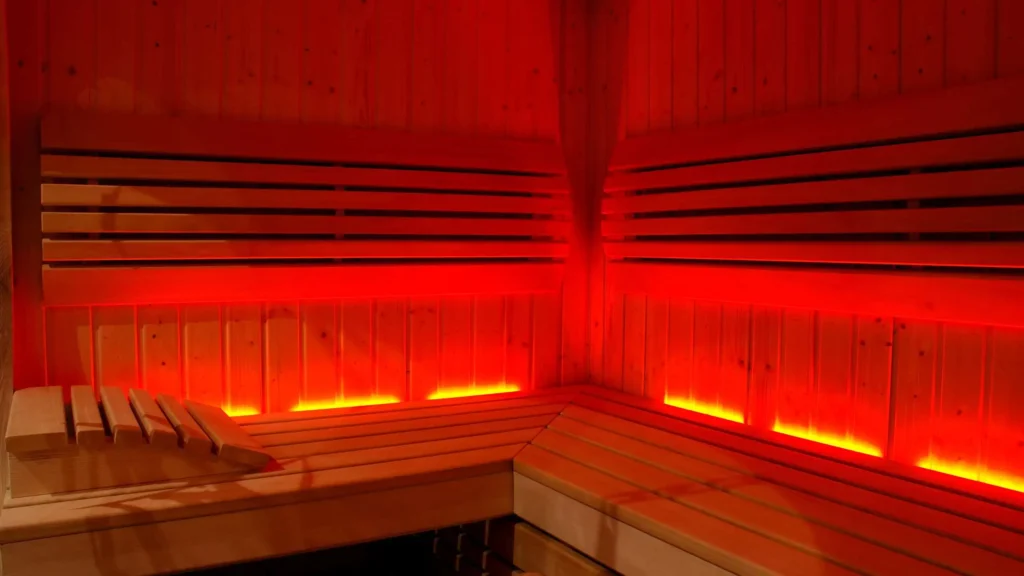Living with rheumatoid arthritis (RA) ain’t a walk in the park. Stiff joints, persistent pain, and that never-ending fatigue – it messes with your day-to-day, right? It’s like your body is throwing a party, but you’re not invited. And trust me, I get it.
RA is an autoimmune condition where the body’s immune system mistakenly attacks its own tissues, leading to inflammation and chronic pain. Symptoms can be brutal, including:
- Joint pain and tenderness
- Swelling and stiffness
- Constant fatigue
- Decreased mobility and flexibility
It’s frustrating, and it can feel like a never-ending cycle of discomfort. But here’s where infrared sauna therapy comes into play.
This is like the secret weapon some folks use to complement their arthritis treatment plan. How’s it different? Well, instead of just heating the air around you, infrared saunas heat your body directly using infrared energy.
Sounds a bit sci-fi, right?
So, what’s the deal with infrared saunas? They work by emitting infrared light, which penetrates your skin and heats your body from the inside out.
This can lead to a bunch of potential benefits, especially for those dealing with chronic pain. Some people say it helps with:
- Pain relief: Many folks report a decrease in arthritis pain after regular sessions.
- Improved blood circulation: The heat can help dilate blood vessels, increasing blood flow and oxygen to your muscles and joints.
- Muscle relaxation: Tight muscles can ease up, making it easier to move around.
- Detoxification: Sweating it out can help remove toxins from your body, which is always a plus.
But, like anything new, there are risks too. It’s not all sunshine and rainbows. Some people might experience dehydration or overheating, especially if they’re not careful about their sauna sessions. So, what’s this article gonna do? I
t’s gonna break down the benefits, potential risks, and practical things you might need to think about if you’re considering throwing sauna therapy into the mix.
We’re gonna chat about how it might help with arthritis pain, look at some scientific studies, and hear from people like you who’ve given it a shot.
For instance, a study published in the Journal of Clinical Rheumatology found that infrared sauna therapy can lead to short-term improvements in pain and stiffness for those with RA. That’s some solid medical evidence backing it up!
And let’s not forget about the emotional side of things. Living with RA can be draining, both physically and mentally. The thought of finding something that might actually help can spark a little hope. It’s like finding a light at the end of a tunnel.
So, whether you’re just curious or seriously considering it, stick around. Let’s see if this infrared sauna thing is worth your time.
Infrared Sauna Therapy
Ever wondered how infrared sauna therapy works? It’s kinda like magic, but with science. Instead of just heating the air around you like traditional saunas, infrared saunas use infrared light to warm up your body directly. Imagine feeling like a cozy loaf of bread in the oven – that’s your body soaking up the heat.
How do infrared saunas work? They emit infrared rays, which penetrate deeper into your skin. This means you’re not just sweating on the surface; you’re getting a deeper heat that can help with pain relief and relaxation. It’s like a warm hug for your muscles and joints.
Now, what’s the big difference between these and the old-school saunas? Well, let’s break it down:
| Traditional Saunas | Infrared Saunas |
|---|---|
| Heats the air around you | Heats your body directly |
| Temps can hit 180°F+ | Temps usually between 120-150°F |
| High humidity | Low humidity |
With infrared, you’re gonna sweat at lower temperatures, which can be more comfortable for people with heat sensitivities or joint pain. Plus, you’re not sitting in a steam room, so the air feels less suffocating.
Let’s talk types. There are three main kinds of infrared saunas:
- Far-infrared saunas: These are the most common. They heat the body from the inside, helping with blood circulation and detoxification.
- Near-infrared saunas: These focus on surface-level healing. Think skin care and wound healing. They use lamps that have a mix of visible and infrared light.
- Full-spectrum saunas: These are like the all-in-one package. They combine far, near, and mid-infrared waves for a broader range of benefits.
Each type has its fans, and it boils down to what you need. Some folks swear by the detox effects of far-infrared, while others love the skin benefits of near-infrared.
So why choose infrared sauna therapy? It’s not just about sweating out toxins. It’s about tapping into those infrared sauna benefits like improved joint mobility, less joint stiffness, and better pain management. And trust me, when you’re dealing with arthritis symptoms, any relief is good relief.
Feeling anxious about trying something new? I get it. But armed with this know-how, you’re already one step closer to figuring out if infrared sauna therapy could be your new go-to for arthritis relief. So, are you ready to give it a shot?
Potential Benefits of Infrared Sauna Therapy
Can infrared sauna therapy really help with rheumatoid arthritis? Heck, yeah! Some studies say it works. Imagine feeling less pain and stiffness just from sitting in a sauna. Sounds like a dream, right?
Let’s talk numbers. A study published in the Journal of Clinical Rheumatology found that people with RA who used infrared saunas reported a 40% reduction in pain and stiffness. That’s not chump change! We’re talking real relief here.
And it’s not just about less pain. It’s about moving better too. People say they get improved joint mobility and even feel a boost in their overall well-being. It’s like their body says, “Thank you!” after each session.
But what do real folks say? Some people with RA swear by these saunas. They talk about feeling more relaxed, less tense, and like they can actually enjoy life a bit more. One person said, “It’s like my joints went on vacation.” Now that’s something we all can get behind.
Here’s a quick rundown of the big benefits you might see:
- Enhanced circulation: More blood flow means more oxygen and nutrients reaching those aching joints.
- Muscle relaxation: Goodbye, tension! Feel those muscles unwind.
- Detoxification: Sweat out those nasty toxins and feel cleaner from the inside out.
Some folks also talk about better sleep after a session, which is a sweet bonus if you struggle with sleep disorders.
So, if you’re fighting the battle with arthritis symptoms, infrared sauna therapy could be that secret weapon you didn’t know you needed. It’s like finding an oasis in a desert of daily pain.
Risks and Precautions
Is infrared sauna therapy all sunshine and rainbows? Not quite. Let’s chat about the risks. Yeah, there are a few things you gotta watch out for. But don’t freak out – we got this.
First up: the potential risks. If you’re overheating, that can be a problem. We’re talking dehydration or even heat exhaustion. And if you’ve got heart issues, well, tread carefully. Your heart might not love the extra heat. It’s crucial to know your body and listen to it. If you start feeling dizzy or lightheaded, it’s time to get out.
Now, for folks with rheumatoid arthritis, there are some things to keep in mind. You gotta be smart about the time and temp. Here’s some advice:
- Duration: Keep it short to start. Like 10-15 minutes. Ease into it. You can gradually increase the time as your body gets used to it.
- Temperature settings: Not too hot. Think low and slow. Start around 120°F – 140°F. If it feels too hot, lower it. Your comfort is key.
Hydration is a biggie. Gotta drink up before and after sauna time. Water is your best buddy here. Dehydration can sneak up on you, especially when you’re sweating it out. Here’s how to stay hydrated:
- Before: Chug some water, maybe a glass or two. You want to start your session well-hydrated.
- After: Replace what you sweat out. Electrolyte drinks can help too. Look for ones that don’t have a ton of sugar.
Also, if you have any existing health conditions, it’s super important to consult with your healthcare provider before jumping into sauna therapy. They can give you tailored advice based on your situation.
For instance, if you have psoriatic arthritis or any other autoimmune conditions, your doctor might have specific recommendations for you.
Another thing to consider is the environment of the sauna itself. Make sure it’s clean and well-maintained.
Some saunas can harbor bacteria if they’re not taken care of. You don’t want to end up with a skin infection or something worse. So, check reviews or ask about the maintenance practices if you’re using a public sauna.
Integrating Infrared Sauna Therapy into a Treatment Plan
So, you’re thinking about adding infrared sauna therapy to your rheumatoid arthritis playbook? Let’s break it down.
First off, it’s not a one-size-fits-all deal. Each person’s RA is its own beast. But here’s how you can weave sauna sessions into your life.
Suggestions for Integration
- Consistency is key: Aim for 2-3 sessions a week. You gotta let your body adjust.
- Mix it up: Combine sauna time with a light stretching routine. Helps those joints stay loose.
- Track your progress: Keep a journal. Note the good days, the bad days, and the sauna days. See if there’s a pattern.
Combining Sauna Therapy with Other Treatments
Infrared sauna therapy ain’t replacing your meds or PT. It’s more of a sidekick. Here’s how to pair them up:
| Treatment | How to Integrate |
|---|---|
| Medication | Take your meds as prescribed. Sauna can help with pain relief, but meds tackle inflammation. |
| Physical Therapy | Do your PT exercises post-sauna. Heat loosens muscles, making stretching more effective. |
| Diet and Nutrition | Hydrate well and maintain a balanced diet. Sauna can aid in detox, but nutrition fuels recovery. |
Case Study: A Real Win
Let’s talk about Jane. A fierce warrior against RA. She started sauna sessions twice a week, in combo with her regular PT. At first, it was tough. The heat was intimidating. But she stuck with it, and after a month, she noticed less stiffness in the mornings.
Her PT exercises felt easier. She even started sleeping better. Jane’s story is a testament to the power of persistence and finding what works for you.
So, if you’re thinking about giving infrared sauna use a shot, remember it’s a piece of the puzzle. Not the whole picture. Chat with your doc, stay consistent, and tune in to your body’s signals. Your path to arthritis relief is unique, and you deserve to find what works best for you.
Conclusion
So, how effective is sauna therapy for arthritis relief? Let’s break it down.
Infrared sauna therapy can be a game changer for many dealing with arthritis symptoms. We’ve talked about the potential benefits like:
- Pain relief: Many folks report a noticeable decrease in joint pain after a session.
- Improved circulation: The heat helps get the blood flowing, which can be super helpful for those stiff joints.
- Muscle relaxation: Who doesn’t love a good muscle chill after a long day?
- Detoxification: Sweating it out can help clear out some of those pesky heavy metals and toxins.
But, let’s not sugarcoat it. There are risks involved too. Some people might experience:
- Dehydration: Sweating is great, but you gotta drink water!
- Overheating: Too much heat can lead to dizziness or worse.
- Potential flare-ups: Some might find that their symptoms get worse after a sauna session.
So, it’s not all sunshine and rainbows. It’s crucial to consult with your healthcare provider before diving into this therapy. They know your health history and can help you figure out if this is a good fit for you.
Now, let’s talk about the big picture. Managing rheumatoid arthritis (RA) is like juggling. You’ve got to keep all the balls in the air. It’s not just about one treatment. It’s a mix of:
- Medications: These are often the first line of defense.
- Exercise: Keeping those joints moving is key.
- Diet: Eating anti-inflammatory foods can make a difference.
- Infrared sauna therapy: This can be a nice addition to your routine.
Think of it like a team sport. You need all your players to win the game. If you’re considering infrared sauna use, it can be a great way to complement your existing treatment plan.
And hey, don’t forget to listen to your body. Everyone’s different. What works for one person might not work for another. Keep track of how you feel after each session. If something doesn’t feel right, don’t hesitate to reach out to your doctor.
In the end, it’s all about finding what works best for you. If infrared sauna therapy helps ease your joint pain and improves your overall health, then that’s a win! Just remember, it’s just one piece of your wellness puzzle.
So, keep it balanced, keep it smart, and keep fighting the good fight. You’ve got this!





